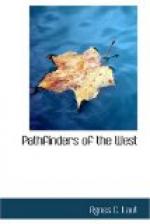Pere Poncet had been captured by the Mohawks the preceding summer, but had escaped to Orange.[12] Embarking on a small sloop, Radisson sailed down the Hudson to New York, which then consisted of some five hundred houses, with stores, barracks, a stone church, and a dilapidated fort. Central Park was a forest; goats and cows pastured on what is now Wall Street; and to east and west was a howling wilderness of marsh and woods. After a stay of three weeks, Radisson embarked for Amsterdam, which he reached in January, 1654.
[1] Benjamin Sulte in Chronique Trifluvienne.
[2] It was in August of this same year, 1652, that the governor of Three Rivers was slain by the Iroquois. Parkman gives this date, 1653, Garneau, 1651, L’Abbe Tanguay, 1651; Dollier de Casson, 1651, Belmont, 1653. Sulte gives the name of the governor Duplessis-Kerbodot, not Bochart, as given in Parkman.
[3] Dr. Bryce has unearthed the fact that in a petition to the House of Commons, 1698, Radisson sets down his age as sixty-two. This gives the year of his birth as 1636. On the other hand, Sulte has record of a Pierre Radisson registered at Quebec in 1681, aged fifty-one, which would make him slightly older, if it is the same Radisson. Mr. Sulte’s explanation is as follows: Sebastien Hayet of St. Malo married Madeline Henault. Their daughter Marguerite married Chouart, known as Groseillers. Madeline Henault then married Pierre Esprit Radisson of Paris, whose children were Pierre, our hero, and two daughters.
[4] A despatch from M. Talon in 1666 shows there were 461 families in Three Rivers. State papers from the Minister to M. Frontenac in 1674 show there were only 6705 French in all the colony. Averaging five a family, there must have been 2000 people at Three Rivers. Fear of the Iroquois must have driven the country people inside the fort, so that the population enrolled was larger than the real population of Three Rivers. Sulte gives the normal population of Three Rivers in 1654 as 38 married couples, 13 bachelors, 38 boys, 26 girls—in all not 200.
[5] At first flush, this seems a slip in Radisson’s Relation. Where did the Mohawks get their guns? New York Colonial Documents show that between 1640 and 1650 the Dutch at Fort Orange had supplied the Mohawks alone with four hundred guns.
[6] One of many instances of Radisson’s accuracy in detail. All tribes have a trick of browning food on hot stones or sand that has been taken from fire. The Assiniboines gained their name from this practice: they were the users of “boiling stones.”
[7] I have asked both natives and old fur-traders what combination of sounds in English most closely resembles the Indian war-cry, and they have all given the words that I have quoted. One daughter of a chief factor, who went through a six weeks’ siege by hostiles in her father’s fort, gave a still more graphic description. She said: “you can imagine the snarls of a pack of furiously vicious dogs saying ‘ah-oh’ with a whoop, you have it; and you will not forget it!”




